Overview
This article shines a light on the important statistics surrounding Type 2 Diabetes, highlighting its prevalence and the associated risks. Over 34 million adults in the U.S. are affected, and this condition carries significant financial implications. Alarmingly, there is also a concerning rise in cases among children. It's understandable to feel overwhelmed by these numbers, but awareness and effective management strategies are crucial in combating this growing health crisis.
By making lifestyle changes, individuals can take proactive steps towards managing their health and even achieving potential remission. Remember, you're not alone in this journey. Many resources and support systems are available to help you navigate this path. Together, we can work towards a healthier future.
Introduction
In a world where Type 2 Diabetes is rapidly becoming a public health crisis, understanding its statistics and implications is more crucial than ever. With over 34 million adults in the U.S. affected and alarming trends showing a 30% increase in cases among children in the last decade, it's understandable to feel concerned about the urgency for effective management and preventive strategies.
T2DSolutions emerges as a pivotal resource, dedicated to equipping individuals with vital information, community support, and educational resources to navigate the complexities of diabetes. By exploring the latest data on prevalence, costs, and health impacts, this article delves into the pressing need for awareness and proactive measures to combat the challenges posed by Type 2 Diabetes. You're not alone in this journey; we are here to support you every step of the way.
T2DSolutions: Your Go-To Resource for Type 2 Diabetes Statistics
T2DSolutions: Your Caring Resource for Type 2 Diabetes Statistics
At T2DSolutions, we understand the challenges you may face when seeking reliable and actionable information about Type 2 Diabetes. As a new resource center, we are dedicated to providing a comprehensive range of statistics, educational materials, and community support, empowering you to navigate the complexities of glucose control with confidence.
It’s important to recognize that recent data reveals a percentage of type 2 diabetes with 5,293 newly diagnosed cases among children and adolescents aged 10 to 19 during 2017-2018. This statistic underscores the growing percentage of type 2 diabetes among various age groups. Additionally, Type 2 Diabetes was noted as the primary or contributing cause on 270,702 death certificates in 2017, highlighting its significant impact on health and the urgent need for effective management strategies.
The financial burden of this condition can be overwhelming. Recent analyses show that individual medical expenses have risen from $10,179 in 2012 to $12,022 in 2022. This increase emphasizes the importance of accurate blood sugar monitoring for effective management and resource allocation. T2DSolutions is here to provide you with the latest statistics on the percentage of type 2 diabetes prevalence, costs, and health impacts, making us an essential resource for patients, families, and healthcare providers alike.
By sharing insights into the percentage of type 2 diabetes management resources and successful community support initiatives, T2DSolutions fosters a deeper understanding of the condition. Our commitment to education and community engagement ensures that individuals affected by Type 2 Diabetes have access to the information and support they need for improved health outcomes.
Remember, you’re not alone in this journey. We encourage you to subscribe to T2DSolutions and join our community to stay updated on the latest resources and information.

Over 34 Million Adults in the U.S. Have Type 2 Diabetes
Recent statistics reveal that over 34 million adults in the United States are living with Type 2 Diabetes, which corresponds to a percentage of type 2 diabetes of approximately 11.6% of the adult population. This significant prevalence highlights the critical need for effective oversight strategies and educational resources, which T2DSolutions aims to provide. It’s understandable to feel overwhelmed by these numbers, but raising awareness and improving access to essential support systems is vital for everyone affected.
Furthermore, data indicates that 39.5% of adults with the condition show non-HDL cholesterol levels of 130 mg/dL or higher, a concerning indicator of cardiovascular disease risk. The financial strain of managing this condition is significant, with additional medical expenses per individual linked to it rising from $10,179 to $12,022 between 2012 and 2022. As the healthcare community continues to address these challenges, T2DSolutions is committed to offering resources that help manage these issues.
It's important to note that women with diabetes face increased rates of heart disease and a higher risk of diabetes-related complications like blindness, kidney disease, and depression. Additionally, the percentage of type 2 diabetes is highest among non-Hispanic Black children, highlighting the necessity for targeted interventions. The occurrence of prediabetes among adolescents, which was about 18% from 2005 to 2016, further emphasizes the significance of early screening and lifestyle changes to avert progression to Diabetes 2.
Effective interventions and lifestyle changes are crucial to reduce the impact of Type 2 Diabetes on the adult population. You’re not alone in this journey; T2DSolutions is here to assist newly diagnosed patients in managing these challenges. Together, we can navigate this path toward better health.
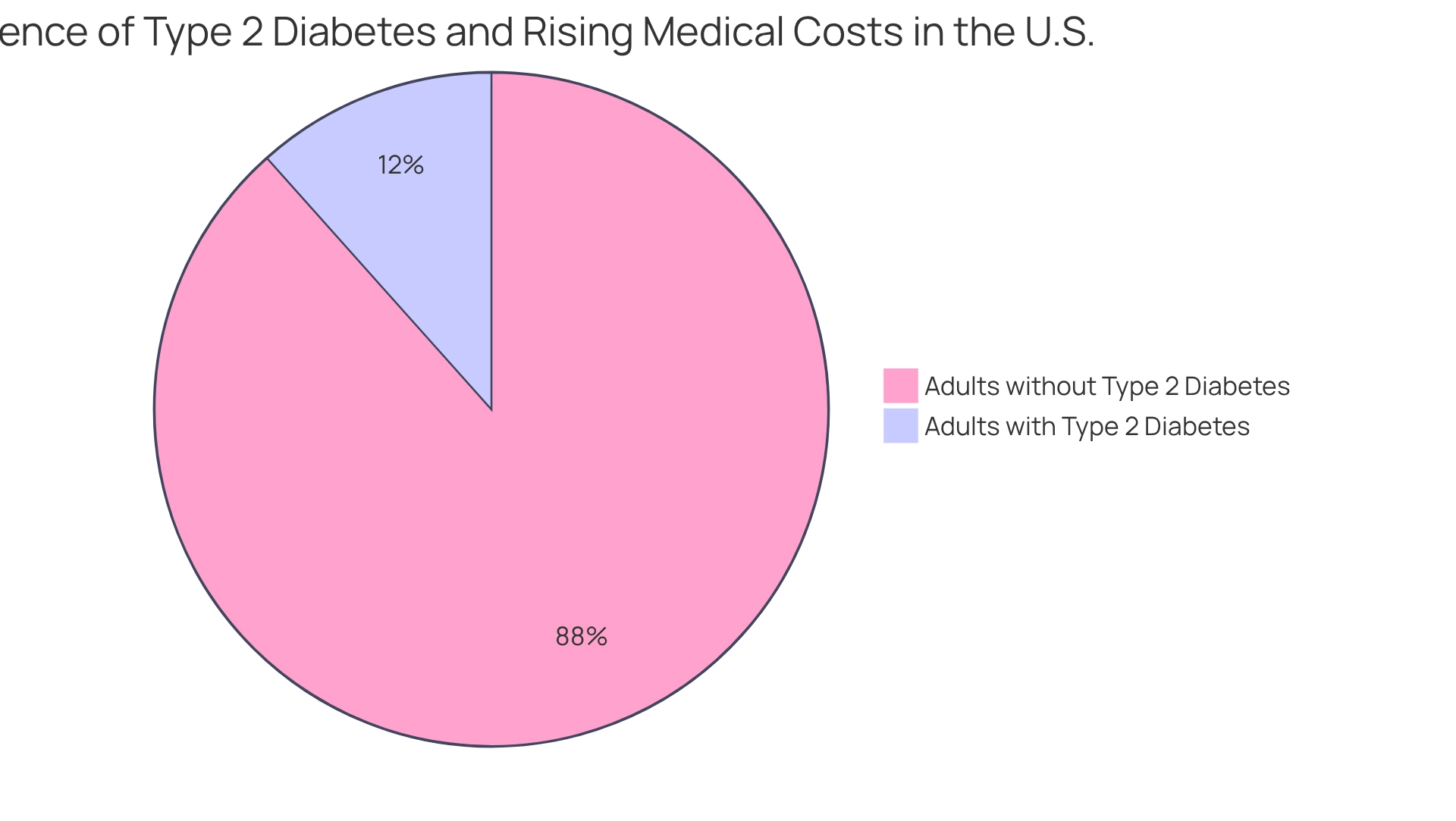
Nearly 90% of Individuals with Type 2 Diabetes Are Overweight or Obese
Did you know that the percentage of type 2 diabetes indicates that almost 90% of individuals diagnosed with this condition are categorized as overweight or obese? This significant connection highlights just how crucial weight regulation is for both preventing and managing the percentage of type 2 diabetes. By making efficient changes—like adopting healthier eating habits and increasing physical activity—you can significantly reduce your chances of developing Type 2 Diabetes, thereby lowering the percentage of type 2 diabetes and improving your overall wellness.
Recent studies have shown that focused weight control programs can lead to remarkable improvements in wellness metrics, particularly for those who are newly diagnosed. Professor Roy Taylor emphasizes that participants in weight loss groups experience significant benefits in their wellness compared to traditional treatments. This underscores the importance of effective weight management.
It's also important to note that factors such as younger age, shorter duration of the condition, not using insulin, and better glycemic control are associated with higher rates of remission. This further emphasizes the need for proactive weight management.
As Kholood M Mugharbel points out, education about diabetes and its complications is vital. Awareness plays a key role in managing this health condition. Additionally, socioeconomic changes in regions like the Middle East have led to increased obesity rates and blood sugar issues, which highlight the urgent need for targeted interventions to address the rising percentage of type 2 diabetes. By prioritizing weight control, you can take proactive steps toward better health management and prevention. Remember, you're not alone in this journey. T2DSolutions is dedicated to providing resources and support for newly diagnosed patients, helping you navigate your path toward effective weight management and understanding your condition. We are here to support you every step of the way.
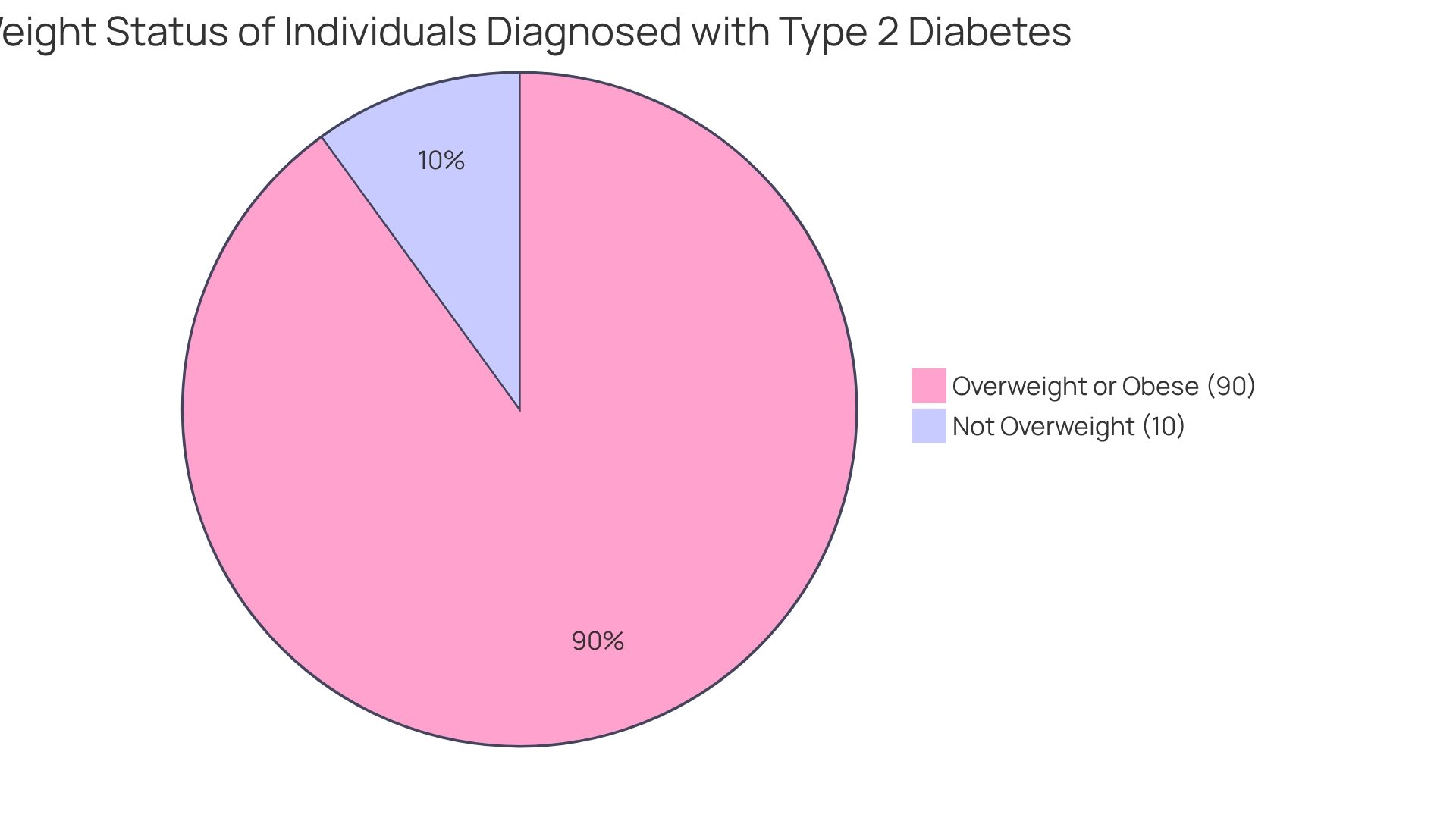
Type 2 Diabetes Cases in Children Have Increased by 30% in the Last Decade
Over the past decade, the percentage of type 2 diabetes among children has surged by 30%. This increase raises significant concerns due to the long-term health implications associated with early-onset diabetes. It's understandable to feel alarmed by this trend, especially as rising rates of childhood obesity and sedentary lifestyles have become prevalent in our society. Recent statistics reveal that approximately 24.3% of children aged 11 to 14 in the UAE are classified as obese, with boys facing higher rates of extreme obesity, highlighted by a staggering 41.4% obesity rate among boys in Kuwait.
Pediatricians emphasize the urgent need for parents and guardians to recognize these trends and actively promote healthy habits from an early age. Effective initiatives aimed at addressing the percentage of type 2 diabetes in children focus on lifestyle changes, such as better dietary selections and increased physical activity. These changes are crucial in combating this expanding epidemic. Additionally, bariatric surgery has been noted as the most effective treatment for youth-onset Type 2 Diabetes, although it comes with significant risks and economic implications.
Understanding these factors is essential for fostering a healthier future for our younger generation. Parents are encouraged to engage their children in regular physical activities and to prioritize nutritious food choices as a family. This lays the groundwork for a healthier lifestyle. Remember, you're not alone in this journey. T2DSolutions is committed to providing resources and support for families navigating these challenges. We offer educational materials and community support to help newly diagnosed patients manage their condition effectively. Together, we can create a supportive environment for our children and help them thrive.

$327 Billion: The Annual Cost of Diabetes in the U.S.
The yearly economic burden of this condition in the United States is an astonishing $327 billion. This figure includes both direct medical costs—such as hospital stays, medications, and outpatient treatment—and indirect expenses arising from lost productivity. This significant financial strain not only affects individuals and families but also places immense pressure on healthcare systems nationwide. It's understandable to feel concerned when you learn that the percentage of patients undergoing nephropathy laboratory tests grew from 30.5% in 2007 to 36.3% in 2014. This trend highlights the increasing focus on managing blood sugar care effectively.
As the occurrence of this condition continues to rise, the necessity for effective oversight strategies and preventive actions becomes ever more crucial. Laura C. Seeff observed that the 6|18 Initiative is enhancing collaborations between state wellness departments and Medicaid agencies. This initiative aids in better Medicaid coverage and the use of effective interventions. By implementing successful cost-reduction strategies, such as promoting preventive care and enhancing patient education, healthcare providers can help mitigate these expenses.
For those who have recently been diagnosed, participating in lifestyle modifications is essential. Embracing a balanced diet and consistent exercise can greatly lessen healthcare expenses related to managing blood sugar levels. Remember, you’re not alone in this journey. Ultimately, these efforts not only enhance health outcomes but also lessen the overall economic effect of the condition on society. T2DSolutions aims to support newly diagnosed patients by providing valuable resources and education to help you manage your condition effectively. We are here to support you every step of the way.
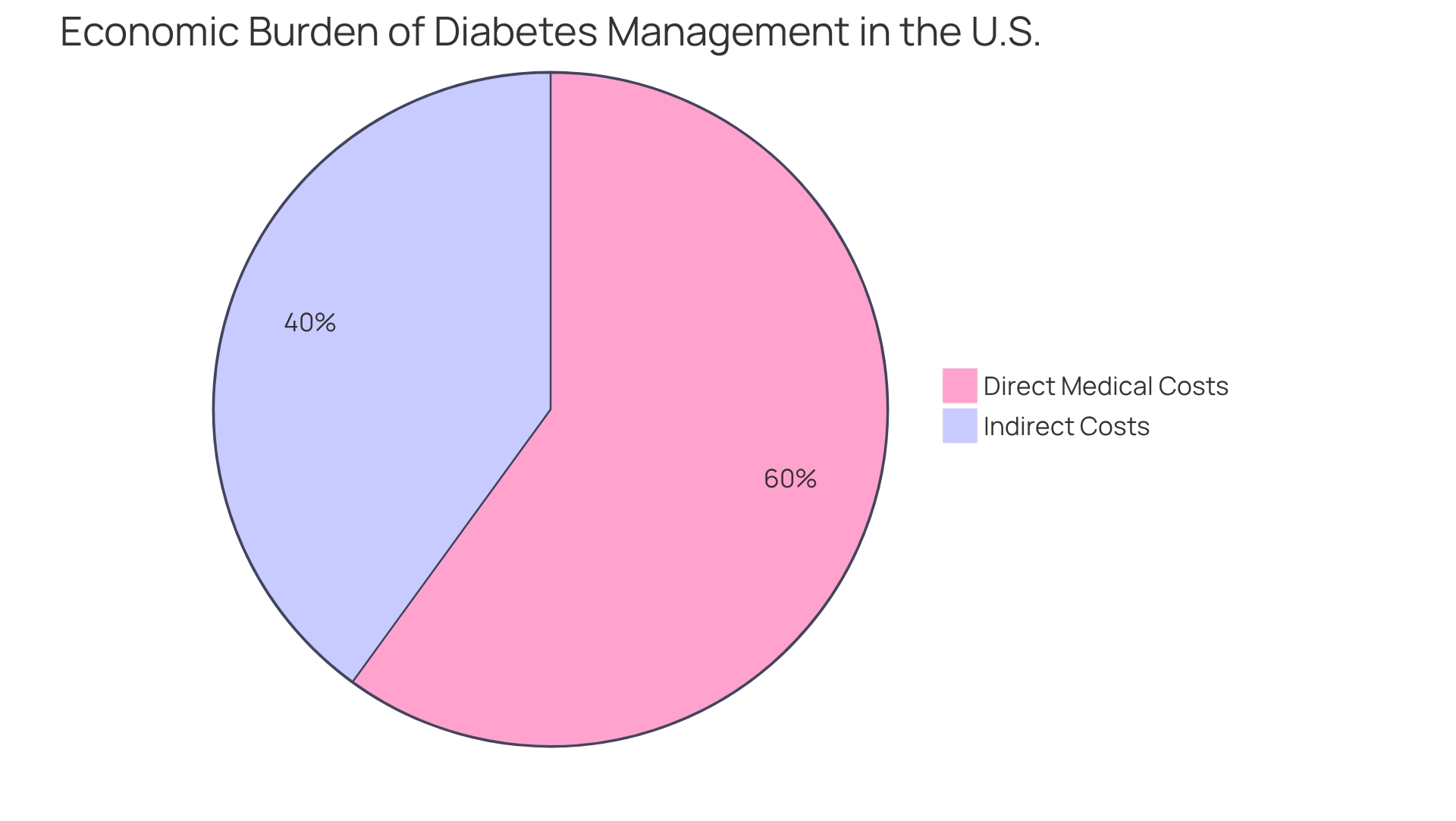
More Than 88 Million Adults Have Prediabetes
An estimated 88 million adults in the U.S. are living with prediabetes, a condition characterized by elevated blood sugar levels that have not yet reached the threshold for a medical diagnosis. This statistic is alarming, particularly given that over 100 million Americans are affected by either blood sugar issues or prediabetes as of 2017. It’s understandable to feel concerned about this; prediabetes is a significant risk factor for the percentage of type 2 diabetes if not addressed promptly.
Studies suggest that early intervention through lifestyle changes—like better nutrition and more physical activity—can significantly reduce the risk of developing diabetes and improve overall wellness. You’re not alone in this journey; T2DSolutions serves as a vital resource for individuals seeking guidance on these lifestyle changes, offering education and support tailored to newly diagnosed patients. Successful lifestyle modification programs have shown promise in reversing prediabetes, underscoring the critical need for awareness and proactive management.
Experts emphasize that recognizing and acting on prediabetes is essential, as timely intervention can lead to better long-term health and reduce the percentage of type 2 diabetes. As Jessica Timmons mentions, "If you or someone dear to you is dealing with the condition, it’s important to keep it well-managed." Additionally, the rising medical costs associated with diabetes, which increased from $10,179 to $12,022 per person from 2012 to 2022, highlight the financial burden of unmanaged prediabetes.
It is crucial to address these issues, particularly in vulnerable populations, as non-Hispanic Black children have shown the highest incidence of Type 2 Diabetes across all years from 2002 to 2018. Taking proactive measures to identify prediabetes and adopt lifestyle changes can significantly influence personal well-being and the broader healthcare system. For additional details on handling prediabetes and related conditions, check out the resources offered at T2DSolutions. We are here to support you every step of the way.
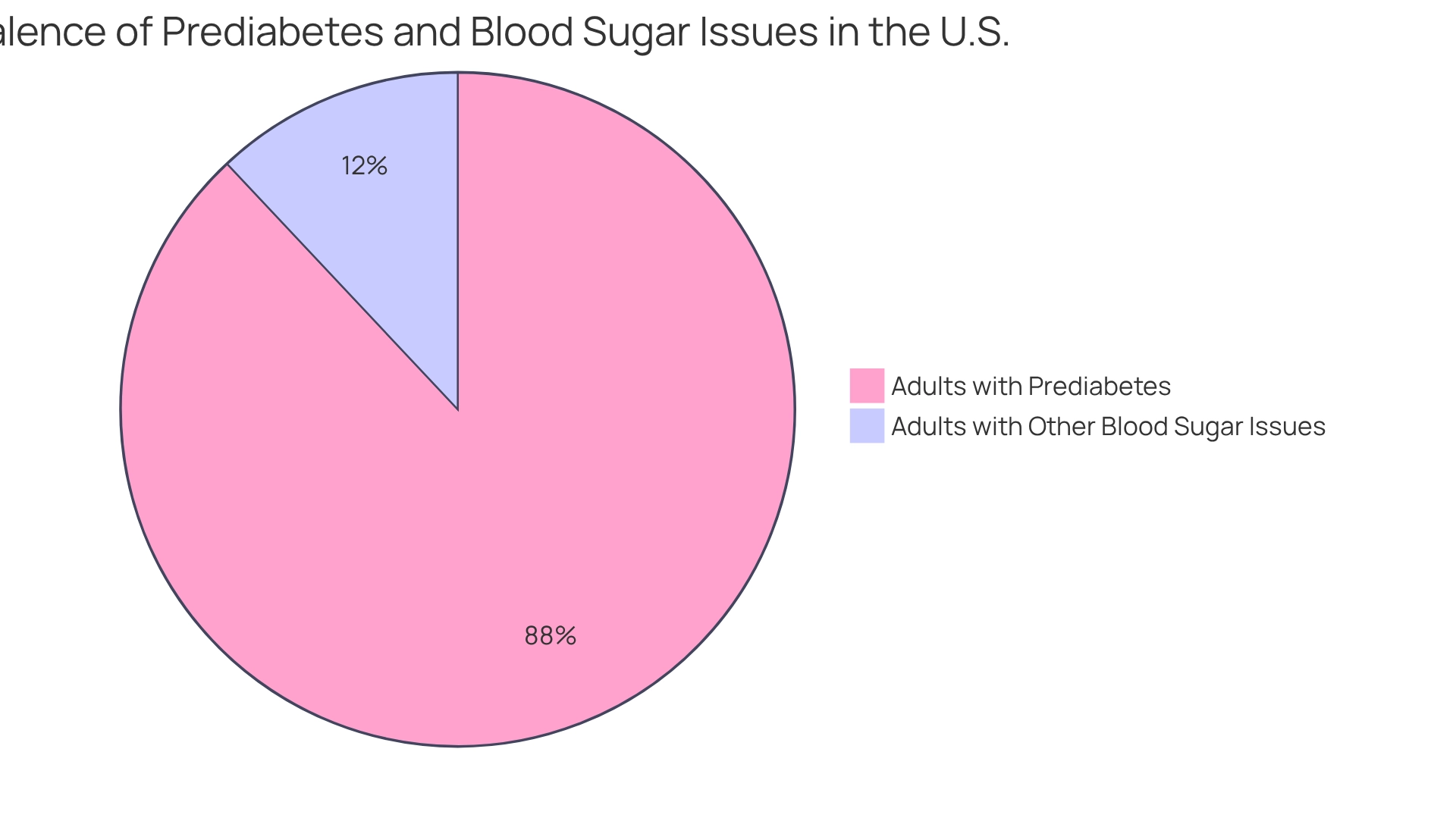
1 in 5 Adults with Diabetes Are Unaware of Their Condition
A staggering 20% of adults living with diabetes are part of the percentage of type 2 diabetes who are unaware of their condition. This statistic highlights a significant public welfare challenge that affects many lives. It's understandable to feel overwhelmed by such information, but recognizing this lack of awareness is the first step toward better health. When diabetes goes undetected for years, it can lead to serious medical issues. Individuals with undiagnosed blood sugar problems face increased risks, including cardiovascular disease and lower-limb amputations. In fact, approximately 73,000 such procedures are performed annually in diabetics aged 20 and older.
Healthcare providers emphasize the necessity of regular screenings. The New USPSTF and ADA guidelines recommend that adults begin screening at age 35 and continue every three years thereafter. Understanding risk factors and symptoms is essential for early identification and effective management of the percentage of type 2 diabetes. Moreover, mental well-being is crucial; individuals with diabetes are twice as likely to experience depression compared to those without the condition. It’s important to know that you are not alone in this journey.
A case study highlights that comprehensive care, which includes psychological support, is vital for improving health outcomes. It promotes a proactive approach to addressing health issues related to diabetes. T2DSolutions seeks to close this awareness gap by offering valuable resources and assistance for newly diagnosed patients. We are here to support you every step of the way, ensuring you have access to the information and tools needed for effective management of your condition. Remember, you are not alone in this journey; support is available, and together we can navigate these challenges.
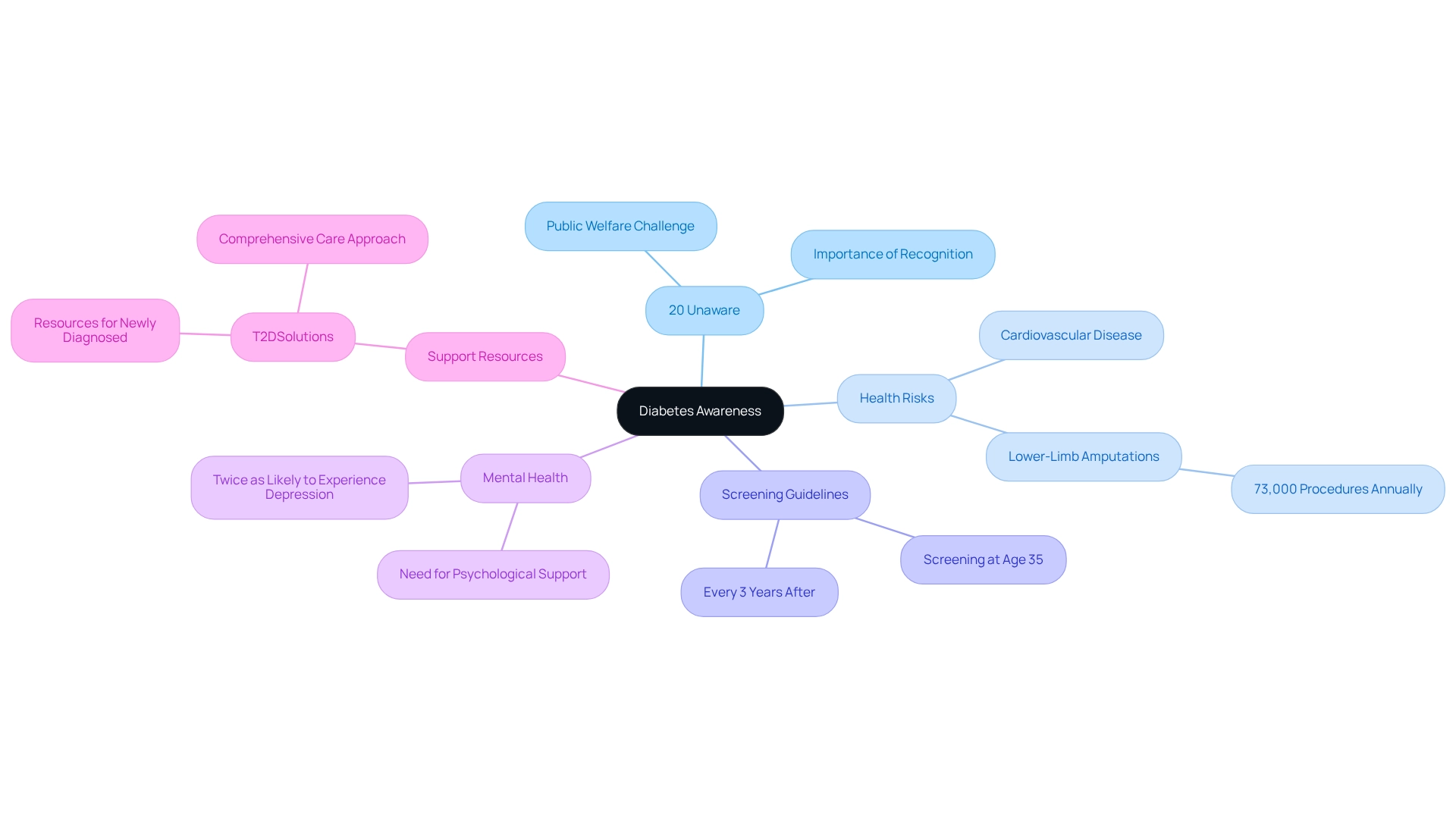
Hispanic and Black Adults Are 50% More Likely to Develop Type 2 Diabetes
Research indicates that the percentage of type 2 diabetes in Hispanic and Black adults is approximately 50% higher compared to their white counterparts. This significant disparity arises from a complex interplay of genetic predispositions, environmental influences, and socioeconomic challenges. For instance, the percentage of type 2 diabetes among Central American, South American, and other Hispanic, Latino, or Spanish adults ranges from 5.0% to 7.3%. Meanwhile, Black adults also face elevated risks due to factors such as limited access to healthcare and educational resources.
It's understandable to feel concerned about these statistics. In fact, as of 2021, the percentage of type 2 diabetes among adults with diabetes was over 22%, equating to 8.7 million individuals who were unaware of their condition. This highlights the urgent need for targeted education and community support initiatives. Tackling these disparities is essential for enhancing wellness results in these communities, and T2DSolutions seeks to contribute significantly to this endeavor.
By providing culturally tailored education and outreach, T2DSolutions can effectively engage minority communities and enhance awareness. Furthermore, precise data gathering techniques for race and ethnicity are crucial in understanding and addressing disparities in well-being. By promoting cooperation among healthcare practitioners, public health specialists, and community organizations, T2DSolutions aims to develop effective strategies to combat the increasing prevalence of diabetes-related issues in minority groups.
According to the CDC, adults aged 40 and above with diagnosed blood sugar issues who received at least two hemoglobin A1c assessments in the calendar year was 77.6% in 2020. This statistic underscores the necessity for consistent monitoring and oversight of blood sugar levels, especially in relation to the percentage of type 2 diabetes across various demographics. You're not alone in this journey—if you need more information and assistance concerning blood sugar management, we encourage you to connect with T2DSolutions. We are here to support you every step of the way.

Individuals with Type 2 Diabetes Are Twice as Likely to Suffer from Heart Disease
If you or someone you know has been diagnosed with Type 2 Diabetes, it’s important to understand the increased risks associated with the percentage of type 2 diabetes. Individuals with this condition face a twofold increase in the likelihood of developing heart disease compared to the percentage of type 2 diabetes in the general population. This heightened risk is often linked to common comorbidities such as hypertension, high cholesterol levels, and obesity, which frequently accompany diabetes.
However, there is hope. Research shows that effectively managing blood glucose levels, along with making strategic lifestyle changes—like adopting a heart-healthy diet and engaging in regular physical activity—can significantly reduce the risk of cardiovascular complications. It’s understandable to feel overwhelmed, but taking these steps can make a real difference.
Moreover, recent studies emphasize the importance of a multifactorial approach to managing both blood sugar and cardiovascular health. This means that addressing glycemic control and cardiovascular risk factors together is crucial. A notable advancement in this area is NT-proBNP testing, which has been proposed as a useful tool for predicting cardiovascular disease (CVD) risk. Monitoring heart health in the context of blood sugar control is vital.
As highlighted by R.J.dS., updates on this important work were presented to the WHO in 2022, showcasing the global acknowledgment of these issues. Additionally, there is a pressing need for improved validation of biomarkers and risk scores in diverse populations, which is essential for providing personalized diabetes care.
A case study titled 'Identifying High CVD Risk in T2DM Patients' explored advanced screening techniques. It demonstrated that combined assessments can enhance risk classification and lead to better management strategies. By prioritizing these techniques, individuals with Type 2 Diabetes can improve their overall well-being and lower their risk of heart disease, especially considering the increasing percentage of type 2 diabetes. Remember, you’re not alone in this journey; we are here to support you every step of the way.

Up to 50% of Individuals Can Reverse Type 2 Diabetes with Lifestyle Changes
Recent studies suggest that nearly 50% of individuals diagnosed with Type 2 Diabetes can achieve remission through meaningful lifestyle changes, which could significantly impact the percentage of type 2 diabetes cases. This highlights the vital importance of early intervention and empowering individuals to take charge of their health.
For instance, the Gow Youth Study revealed that those who adhered to a very-low-energy diet saw significant improvements, with 50% of participants achieving remission, which reflects a notable percentage of type 2 diabetes cases compared to those who did not follow the diet. Moreover, research indicates that remission rates can differ based on specific lifestyle modifications.
For example, recent data shows that remission was only 3% among those diagnosed recently, but this figure rose to 8% for individuals who experienced substantial weight loss. These findings clearly demonstrate the profound impact of lifestyle changes on remission rates, reinforcing the importance of adopting healthy dietary patterns and engaging in regular physical activity to lower the percentage of type 2 diabetes.
Long-term prevention trials emphasize these changes, advocating for a nonpharmacologic approach to managing Type 2 Diabetes. Experts suggest that rigorous research is needed to fully understand the effects of whole food plant-based diets compared to other dietary interventions.
This growing body of evidence supports the idea that lifestyle changes not only have the potential to reverse Type 2 Diabetes but also to enhance overall well-being. If you are newly diagnosed, it’s important to actively explore these options. You're not alone in this journey; valuable resources and community support are available at T2DSolutions, which aims to empower individuals in their diabetes management. For more information on effective strategies and support, we encourage you to visit T2DSolutions.
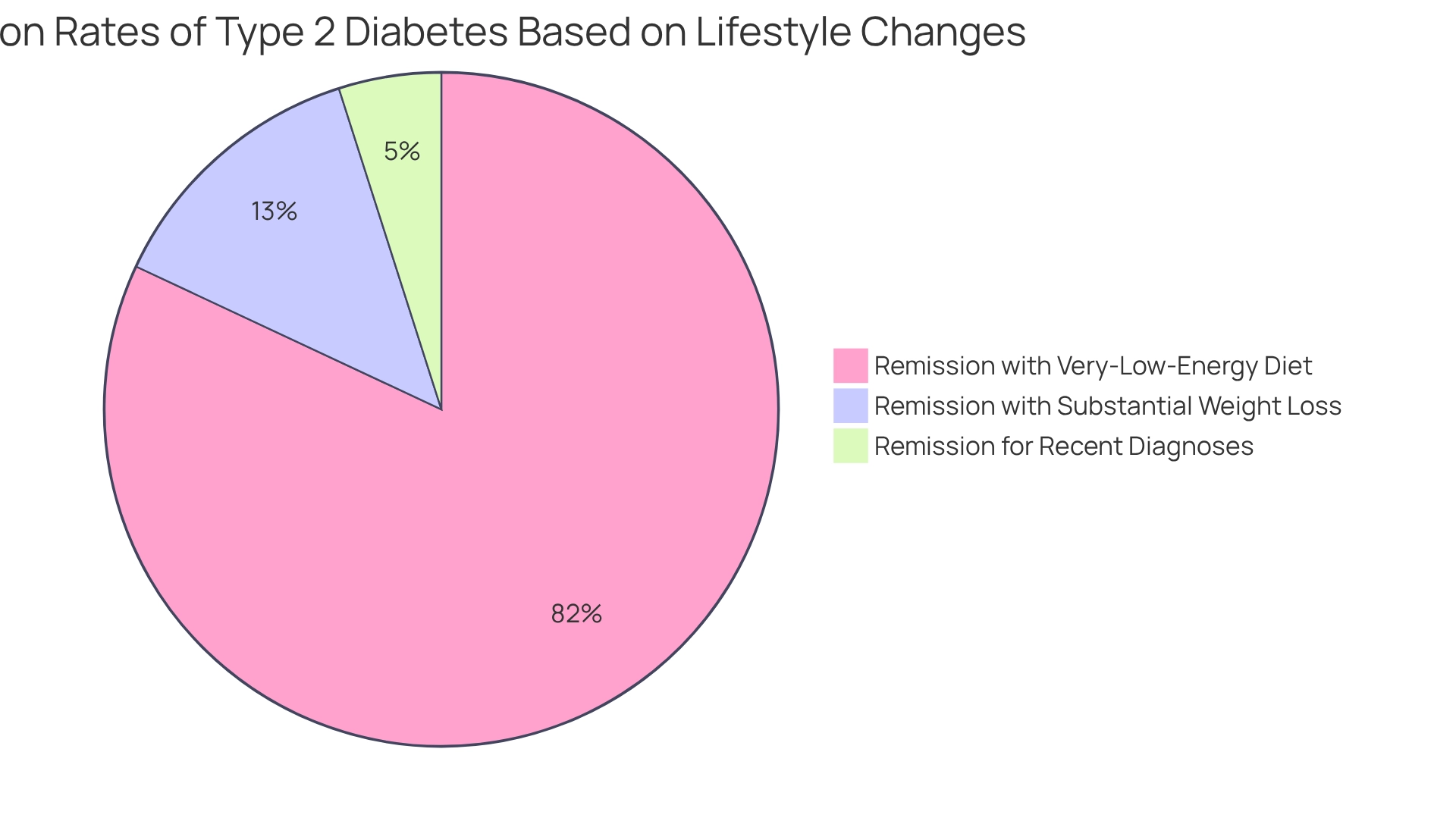
Conclusion
The growing prevalence of Type 2 Diabetes is a pressing public health concern that demands our immediate attention and action. With over 34 million adults affected in the U.S. and alarming statistics revealing a 30% increase in cases among children over the past decade, it is clear that effective management and preventive strategies are crucial. T2DSolutions serves as an essential resource, providing valuable information, educational tools, and community support to help you navigate the complexities of diabetes.
Understanding the significant financial burden associated with diabetes, which has escalated to an annual cost of $327 billion, highlights the urgent need for proactive measures. It’s vital that individuals with prediabetes and those unaware of their condition are educated and encouraged to adopt healthier lifestyles to mitigate the risk of developing Type 2 Diabetes. Moreover, addressing disparities in diabetes prevalence among different racial and ethnic groups is essential for improving health outcomes and ensuring equitable access to resources.
Ultimately, the journey toward managing Type 2 Diabetes is one that requires collective effort, awareness, and empowerment. By embracing lifestyle changes and utilizing the resources provided by T2DSolutions, you can take significant steps toward better health and potentially reverse your condition. Remember, you’re not alone in this journey. The commitment to education, community support, and proactive management can foster a future where Type 2 Diabetes is not just managed but is significantly reduced in prevalence and impact. Together, we can fight against this epidemic, leading to healthier lives and stronger communities.
Frequently Asked Questions
What is T2DSolutions?
T2DSolutions is a resource center dedicated to providing reliable information, statistics, educational materials, and community support for individuals affected by Type 2 Diabetes.
What recent statistics are available regarding Type 2 Diabetes in children and adolescents?
During 2017-2018, there were 5,293 newly diagnosed cases of Type 2 Diabetes among children and adolescents aged 10 to 19.
How significant is Type 2 Diabetes as a cause of death?
In 2017, Type 2 Diabetes was noted as the primary or contributing cause on 270,702 death certificates, indicating its serious impact on health.
What are the rising medical expenses associated with Type 2 Diabetes?
Individual medical expenses related to Type 2 Diabetes rose from $10,179 in 2012 to $12,022 in 2022, highlighting the financial burden of managing the condition.
How prevalent is Type 2 Diabetes among adults in the United States?
Over 34 million adults in the United States are living with Type 2 Diabetes, which represents approximately 11.6% of the adult population.
What cardiovascular risks are associated with Type 2 Diabetes?
Data indicates that 39.5% of adults with Type 2 Diabetes have non-HDL cholesterol levels of 130 mg/dL or higher, which is a risk factor for cardiovascular disease.
What complications are women with diabetes more susceptible to?
Women with diabetes face increased rates of heart disease and a higher risk of diabetes-related complications, including blindness, kidney disease, and depression.
What is the significance of prediabetes among adolescents?
The occurrence of prediabetes among adolescents was about 18% from 2005 to 2016, emphasizing the need for early screening and lifestyle changes to prevent progression to Type 2 Diabetes.
How does weight relate to the management of Type 2 Diabetes?
Almost 90% of individuals diagnosed with Type 2 Diabetes are categorized as overweight or obese, highlighting the importance of weight regulation for prevention and management.
What role does education play in managing Type 2 Diabetes?
Education about diabetes and its complications is vital for effective management, as awareness significantly influences health outcomes.
How does T2DSolutions support individuals newly diagnosed with Type 2 Diabetes?
T2DSolutions provides resources and support to help newly diagnosed patients manage their condition effectively and navigate their health journey.



